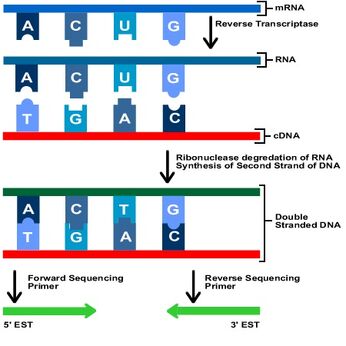Expressed Sequence Tags (ESTs) are small pieces of DNA sequences that are usually000 nucleotides long and are used to locate a gene within the genome.
ESTs are generated by sequencing either the very beginning or the very end of an expressed gene. The 5'EST usually contain conserved sequences among gene families (ie. genes that have similar functions) and will link an unknown gene to its 'gene family'. The 3'ESTs are usually more unique to a specific gene because they contain sequences that are more specific to the gene. 3'ESTs are more likely to help identify where in the genome the gene of interest is located.

ESTs are generated by sequencing cDNA, which itself is synthesized from the mRNA molecules in a cell. The mRNAs in a cell are copies of the genes that are being expressed. mRNA does not contain sequences from the regions between genes, nor from the non-coding introns that are present within many interesting parts of the genome. (1)
The diagram shows how to make an EST.
ESTs are produced by isolating the mRNA of interest and using reverse transcriptase to produce a cDNA. The first and last 200-500 nucleotides are sequenced. Those sequences are then matched to an area in an already sequenced genome. This provides the location of the gene. The 5' & 3' ESTs can then be used to make primers to sequence the whole cDNA.
Reference:
NCBI. ESTs Factsheet. Last modified Mar 29 2004. http://www.ncbi.nlm.nih.gov/About/primer/est.html